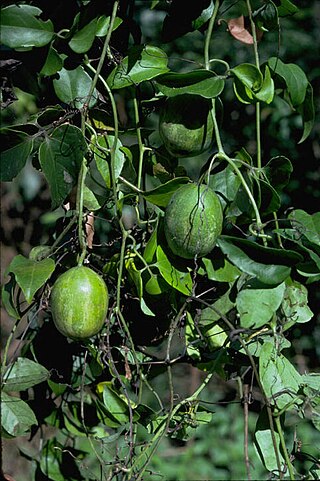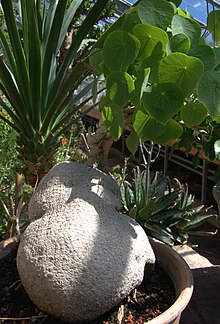
Menispermaceae is a family of flowering plants. The alkaloid tubocurarine, a neuromuscular blocker and the active ingredient in the 'tube curare' form of the dart poison curare, is derived from the South American liana Chondrodendron tomentosum. Several other South American genera belonging to the family have been used to prepare the 'pot' and 'calabash' forms of curare. The family contains 78 genera with some 440 species, which are distributed throughout low-lying tropical areas with some species present in temperate and arid regions.

Grass jelly, also known as leaf jelly or herb jelly, is a jelly-like dessert originating from China. It is commonly consumed in East Asia and Southeast Asia. It is created by using Chinese mesona and has a mild, slightly bitter taste. Grass jelly was invented by the Hakka people who historically used the food to alleviate heat stroke after long days working in the field. The dish was introduced to Southeast Asia by the Chinese diaspora. It is served chilled, with other toppings such as fruit, or in bubble tea or other drinks. Outside Asia, it is sold in Asian supermarkets.

Spondias is a genus of flowering plants in the cashew family, Anacardiaceae. The genus consists of 17 described species, 7 of which are native to the Neotropics and about 10 are native to tropical Asia. They are commonly named hog plums, Spanish plums, libas in Bikol and in some cases golden apples for their brightly colored fruit which resemble an apple or small plum at a casual glance. They are only distantly related to apple and plum trees, however. A more unequivocal common name is mombins.

Breynia is a genus in the flowering plant family Phyllanthaceae, first described in 1776. It is native to Southeast Asia, China, Réunion, the Indian Subcontinent, Papuasia and Australia.

Ulmus davidiana var. japonica, the Japanese elm, is one of the larger and more graceful Asiatic elms, endemic to much of continental northeast Asia and Japan, where it grows in swamp forest on young alluvial soils, although much of this habitat has now been lost to intensive rice cultivation.

Stephania is a genus of flowering plants in the family Menispermaceae, native to eastern and southern Asia and Australia. They are herbaceous perennial vines, growing to around four metres tall, with a large tuber. The leaves are arranged spirally on the stem and are peltate, with the leaf petiole attached near the centre of the leaf. The name Stephania comes from the Greek, "a crown". This refers to the anthers being arranged in a crown-like manner.

The Field Elm cultivar Ulmus minor 'Propendens', described by Schneider in 1904 as U. glabra (:minor) var. suberosa propendens, Weeping Cork-barked elm, was said by Krüssmann (1976) to be synonymous with the U. suberosa pendula listed by Lavallée without description in 1877. Earlier still, Loudon's Arboretum et Fruticetum Britannicum had included an illustration of a pendulous "cork-barked field elm", U. campestris suberosa. An U. campestris suberosa pendula was in nurseries by the 1870s.
The Field Elm cultivar Ulmus minor 'Microphylla Pendula', the Weeping small-leaved elm, was first listed by the Travemünde nursery, Lübeck, and described by Kirchner in Petzold & Kirchner's Arboretum Muscaviense (1864), as Ulmus microphylla pendulaHort.. By the 1870s it was being marketed in nurseries in Europe and America as Ulmus campestris var. microphylla pendula.
The hybrid elm cultivar Ulmus × hollandica 'Elegantissima' was the name given by A. R. Horwood in his Flora of Leicestershire and Rutland (1933) to an elm found in those counties and later identified by Melville as a natural hybrid between Wych Elm and Plot Elm. According to Melville, the hybrid occurs in the main areas of Plot Elm distribution, where it is more common than Plot Elm itself. The tree is sometimes known simply as the 'Midlands Elm'.

Nothoalsomitra suberosa is a species of subtropical vines in the family Cucurbitaceae, the only member of the monotypic genus Nothoalsomitra. Native to Queensland in Australia.

Trichilia emetica is a tree in the family Meliaceae, commonly known as the Natal mahogany. It is an evergreen tree, with handsome glossy dark green leaves and a wide spreading crown. Its sweet-scented flowers attract bees and birds.
Stephania reticulata is a shrub native to Myanmar, Thailand, Laos, Borneo and Java. It was described by Lewis Leonard Forman in 1956.
Stephania crebra is a herbaceous perennial vine in the genus Stephania of the family Menispermaceae. It is native to Southeast Asia and was first described in Thailand in 1988 by L. L. Forman. It is one of 15 Stephania found only in northern Thailand, specifically in the province of Chiang Mai. It has leaves 12–17 cm (4.7–6.7 in) long and 9–16 cm (3.5–6.3 in) wide. It resembles Stephania reticulata but S. crebra has larger flowers but smaller drupes and endocarps.
Lewis Leonard Forman was a British botanist, born in London. He was an expert on spermatophytes, particularly Menispermaceae, and specialised in the plants of Southeast Asia. He graduated from the University of London in 1950 and was appointed to the staff of the Royal Botanic Gardens, Kew in 1951, serving as a senior official there from 1966 to 1989.
Stephania tomentella is a herbaceous perennial vine of the family Menispermaceae and genus Stephania. It is native to Southeast Asia and was first described in Thailand in 1988 by L. L. Forman. It is one of 15 Stephania found only in northern Thailand, specifically in the area around Chiang Rai. It has leaves measuring 7–9 cm (2.8–3.5 in) in both width and length. It is commonly found amongst limestone rocks.
Campylopetalum is a monotypic genus of shrubs in the subfamily Anacardioideae of the cashew and sumac family Anacardiaceae. It contains the single species Campylopetalum siamense, which is endemic to northern Thailand.

The Field Elm cultivar Ulmus minor 'Suberosa', commonly known as the Cork-barked elm, is a slow-growing or dwarf form of conspicuously suberose Field Elm. Of disputed status, it is considered a distinct variety by some botanists, among them Henry (1913), Krüssmann (1984), and Bean (1988), and is sometimes cloned and planted as a cultivar. Henry said the tree "appears to be a common variety in the forests of central Europe", Bean noting that it "occurs in dry habitats". By the proposed rule that known or suspected clones of U. minor, once cultivated and named, should be treated as cultivars, the tree would be designated U. minor 'Suberosa'. The Späth nursery of Berlin distributed an U. campestris suberosa alataKirchn. [:'corky-winged'] from the 1890s to the 1930s.
The elm cultivar Ulmus 'Turkestanica' was first described by Regel as U. turkestanica in Dieck, Hauptcat. Baumschul. Zöschen (1883) and in Gartenflora (1884). Regel himself stressed that "U. turkestanica was only a preliminary name given by me; I regard this as a form of U. suberosa" [:U. minor ]. Litvinov considered U. turkestanicaRegel a variety of his U. densa, adding that its fruits were "like those of U. foliaceaGilibert" [:U. minor].
Viridivia is a monotypic genus of flowering plants belonging to the family Passifloraceae. It only contain one known species, Viridivia suberosa. It is also in the subfamily Passifloroideae and tribe Paropsieae.

Erythrina suberosa, the corky coral tree, is a species of flowering plant in the family Fabaceae. It is native to the Indian Subcontinent, Southeast Asia, and Peninsular Malaysia. Due to its showy flowers and habit of flowering most of the year, it is often planted as an ornamental or street tree. Although the flowers can be used to make a refreshing drink, the seeds are poisonous.











